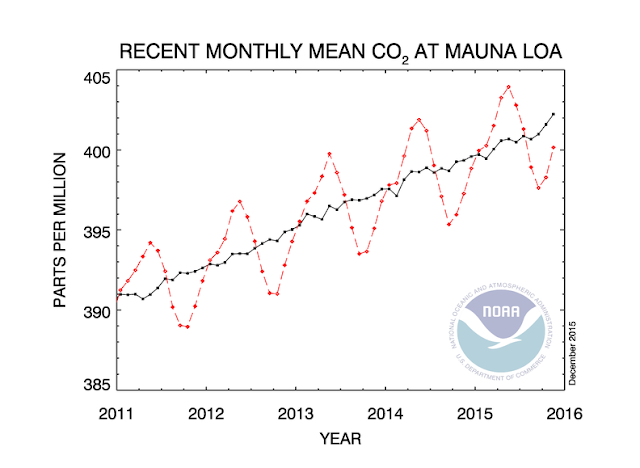I often ask the following question in a final exam in General Chemistry: "Why does natural gas (mostly
methane, CH
4) have the least amount of CO
2 produced per
energy content?". Carbon dioxide (CO
2) is one of the major greenhouse gases emitted as a result of human activity. As the amount of CO
2 has reached the milestone of 400 ppm this year, countries have began making pledges called “intended nationally determined contributions” (INDC's).
 |
| Above copied from NOAA |
There is a
pledge tracker on the internet that displays what countries have promised so far. There is an entry from the Philippines made on
October 2015:
A reduction in emissions of about 70% by 2030, relative to a business-as-usual scenario, on the condition of international support.
One can compare the above with what
Thailand submitted:
An unconditional 20% reduction in emissions by 2030, compared to business-as-usual levels. This could increase to 25%, conditional upon the provision of international support.
Although the Philippines is offering a much greater reduction, the promise is conditional. Thailand offers a 20% reduction without any condition.
How the Philippines intends to reduce emissions by 70 percent is actually not clear. Not surprising, only a few days after the Philippines' pledge, doubts have been raised.
Returning to the final exam question I mentioned at the beginning of this post, the type of fuel used determines the amount of carbon dioxide emitted for every unit of energy output. The
U.S. Energy Information Administration provides the following table
How much carbon dioxide is produced when different fuels are burned?
Different fuels emit different amounts of carbon dioxide (CO2) in relation to the energy they produce when burned. To analyze emissions across fuels, compare the amount of CO2 emitted per unit of energy output or heat content.
Pounds of CO2 emitted per million British thermal units (Btu) of energy for various fuels:
| Coal (anthracite) | 228.6 |
| Coal (bituminous) | 205.7 |
| Coal (lignite) | 215.4 |
| Coal (subbituminous) | 214.3 |
| Diesel fuel and heating oil | 161.3 |
| Gasoline | 157.2 |
| Propane | 139.0 |
| Natural gas | 117.0 |
The amount of CO2 produced when a fuel is burned is a function of the carbon content of the fuel.
Seeing that coal is the worse fuel when it comes to greenhouse emission, it is understandable why a recent article by Inday Espina-Varona in
UCANews is strongly questioning Philippines' sincerity.
These climate change plans are for the coming generations. These are for our children. The world is a large classroom and what a country does teaches its children.




Comments
Post a Comment